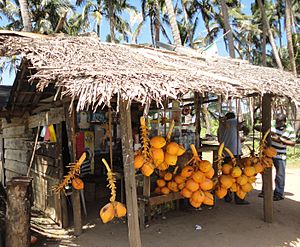King coconut facts for kids
The King Coconut (Cocos nucifera) is a special type of coconut tree. It comes from Sri Lanka, an island country. In Sri Lanka, people call it Thæmbili (which is තැඹිලි in the Sinhala language).
King coconuts are known for their sweet, refreshing water. This water has less sugar than regular coconuts. The trees are usually shorter than other coconut trees. You can often find them growing wild in many parts of Sri Lanka.
There are a few different kinds of King Coconuts. One common type is called "red dwarf" (or kaha thæmbili). Another is "Ran Thæmbili," which is a smaller type. It can have about forty nuts in one bunch!
What Makes King Coconut Special?
King coconut water has been used for a long time in Ayurveda. This is a traditional system of medicine from India. People sometimes mix Aralu powder (from a plant called Myrobalans) with king coconut water.
Today, you can even buy packaged king coconut water. Sri Lanka sends this healthy drink to many other countries.
Different Kinds of Coconuts in Sri Lanka
Sri Lanka has many different types of coconut trees. Scientists at the National Coconut Research Institute study these varieties. They have found many new types of coconuts in different parts of the country.
Coconuts in Sri Lanka are put into 15 different groups. These groups belong to three main types: 'Typica', 'Nana', and 'Aurantiaca'. Scientists look at how the trees and nuts appear. This helps them classify each new type. King coconut is part of the 'Aurantiaca' group.
You can also find a type of red coconut in some parts of Kerala, India. They call it (Chomana Thenga) there.
Common Coconut Varieties
Here are some of the interesting coconut types found in Sri Lanka:
- Sri Lanka Tall: This is a tall tree. It usually starts growing nuts in 6 to 7 years. Each year, one tree can produce 60 to 80 medium-sized nuts.
- Gon Thæmbili: This type is similar to the Sri Lanka Tall. But its nuts, leaf stems, and flowers are ivory-colored.
- Nawasi: Also like the Sri Lanka Tall. The soft inside part of the young nut can be eaten. When it's mature, it gives soft fiber.
- Pora pol: This type is similar to the Sri Lanka Tall. Its nuts have a very thick shell.
- Ran Thæmbili: This is like the Sri Lanka Tall. The inside of the young fruit is pink. It also has a pink ring under the flower parts. The nuts are large.
- Kamandala: Similar to the Sri Lanka Tall. These trees have very large nuts, but only a few (2 to 5) in each bunch.
- Bodiri: Like the Sri Lanka Tall. These nuts are small, but a tree can have many of them (30 to 100) in one bunch. They produce nuts only at certain times of the year.
- Dikiri: Similar to the Sri Lanka Tall. Some of these nuts have a jelly-like inside.
- King Coconut: This tree is not too tall or too short. It starts growing nuts in 6 to 7 years. The nuts are medium-sized and have an orange skin. The water inside is sweet. One bunch can have 25 to 50 nuts.
- Nawas Thæmbili: This is similar to the King Coconut. It has a soft, edible inside part, just like the Nawasi type.
- Rathra Thæmbili: Similar to the King Coconut. It has a pink inside part and a pink ring under the flower parts.
- Green Dwarf: This is a short tree. It starts growing nuts very early, in 3 to 4 years. The nuts are small and have green skin. One tree can produce 80 to 150 nuts each year.
- Yellow Dwarf: Similar to the Green Dwarf. Its nuts have yellow skin.
- Red Dwarf: Also like the Green Dwarf. Its nuts have red skin.
- Brown Dwarf: Similar to the Green Dwarf. Its nuts have brown skin.



